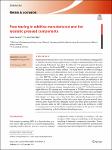Item Infomation
Full metadata record
| DC Field | Value | Language |
|---|---|---|
| dc.contributor.author | Nudelis, Natan | - |
| dc.contributor.author | Mayr, Peter | - |
| dc.date.accessioned | 2023-09-18T04:25:57Z | - |
| dc.date.available | 2023-09-18T04:25:57Z | - |
| dc.date.issued | 2023 | - |
| dc.identifier.uri | https://link.springer.com/article/10.1007/s10853-023-08907-4 | - |
| dc.identifier.uri | https://dlib.phenikaa-uni.edu.vn/handle/PNK/9067 | - |
| dc.description | CC-BY | vi |
| dc.description.abstract | Despite past scientific efforts and the increased use of hot isostatic pressing (HIP) in additive manufacturing applications, a complete understanding of the exact pore-closing behaviour has yet to be achieved. The present research focuses on laser powder bed fused (LPBF), hot isostatic pressed components made of AlSi10Mg, and process-related defects. The study shows the effect of HIPing in relation to various pore characteristics, such as pore shape, size, and type. A pore tracing method using X-ray data was developed to characterise the pores before and after HIP. The method is based on the k-nearest neighbours approach and allows to match leftover pores with the initial ones. Hence, the efficiency of the pore-closing behaviour for different HIP settings can be analysed. Moreover, the exact number of pore transformations can be tracked, providing a comprehensive insight into the change of pore characteristics during HIP. In this framework, eight different HIP settings and a total number of 274,886 pores were examined and discussed. | vi |
| dc.language.iso | en | vi |
| dc.publisher | Springer | vi |
| dc.subject | LPBF | vi |
| dc.subject | AlSi10Mg | vi |
| dc.title | Pore tracing in additive manufactured and hot isostatic pressed components | vi |
| dc.type | Book | vi |
| Appears in Collections | ||
| OER - Khoa học Vật liệu, Ứng dụng | ||
Files in This Item:

